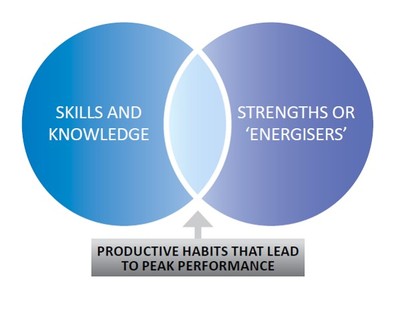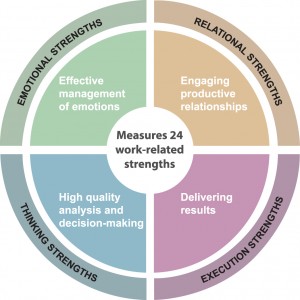Strengths set to boost employee performanceWritten on the 28 November 2014 by Ana Loback, Strengths Partnership, UK Boosting employee performancePeak performers are fascinating top achievers who perform at their best and exceed limits across all disciplines inspire people all over the world. However, if you study the world's greatest achievers you soon find out that actually there is no secret recipe for instant success. In fact, we're all capable of far more than we ever dreamed. The definition of peak performance suggests different facets and emphasises both internal and external criteria, such as satisfaction, focus and energy (internal) and productivity and performance (external). Our research indicates that peak performance happens when people are able to successfully combine their unique strengths with their skills, knowledge and abilities experiencing 'flow'(1) , a mental state of operation in which you're fully immersed in what you are doing, leading to success in the process of that activity.
Know their strengths. Strengths are the underlying qualities that energise people and help them to perform at their best. They are internal sources of energy that enable you to become a peak performer in those areas that naturally motivate you. Research shows that when organisations focus on optimising employees' strengths, engagement increases significantly, setting off a positive chain reaction that leads to improved business results such as productivity and customer loyalty(2). Knowing your employees' strengths allows you not only to understand them better but also ensure that you create the right opportunities to maximise their potential through playing to strengths. It also creates a common ground where you can have more empowering and positive performance conversations, to explore development through what strengthens your people, rather than what weakens them.  Have a mission. Whether it's quality, profit or service; being the best at what you're doing or rising to the top, everyone needs a mission, a reason to perform at their best. Charles Garfield, author of the widely acclaimed "Peak Performance" trilogy which focused on high-performing individuals, teams, and organisations, has studied high achievers for more than thirty years. He claims that peak performance begins with a mission. His interest in peak performance came from his first job as a scientist, part of the Apollo XI team. Garfield noticed at the time that the people involved in the Apollo XI mission to the moon were doing the best work in their lives and he wanted to know why. In multiple facilities around the United States, workers averaged 30 to 40% increases in productivity, and adequate to good performers were suddenly doing great work. One day, out of frustration, he grabbed his boss and asked what was going on. His boss pulled him out into the parking lot and pointed to the moon, telling him that the reason why everyone was working so hard was because they had a mission. He continued to study peak performers for more than 30 years and across many disciplines he always found thiscommon theme. People want to be part of the best, part of an organisation that makes a significant contribution, and they want to be proud of their work. Have a mission. Whether it's quality, profit or service; being the best at what you're doing or rising to the top, everyone needs a mission, a reason to perform at their best. Charles Garfield, author of the widely acclaimed "Peak Performance" trilogy which focused on high-performing individuals, teams, and organisations, has studied high achievers for more than thirty years. He claims that peak performance begins with a mission. His interest in peak performance came from his first job as a scientist, part of the Apollo XI team. Garfield noticed at the time that the people involved in the Apollo XI mission to the moon were doing the best work in their lives and he wanted to know why. In multiple facilities around the United States, workers averaged 30 to 40% increases in productivity, and adequate to good performers were suddenly doing great work. One day, out of frustration, he grabbed his boss and asked what was going on. His boss pulled him out into the parking lot and pointed to the moon, telling him that the reason why everyone was working so hard was because they had a mission. He continued to study peak performers for more than 30 years and across many disciplines he always found thiscommon theme. People want to be part of the best, part of an organisation that makes a significant contribution, and they want to be proud of their work.
Be a peak performer. Peak performers inspire people. If you want to foster peak performance around you, lead by example and commit to achieving peak performance. Set the standard for excellence around you and become a role model for excellence within your organisation. People are most inspired to achieve peak performance when they work in an organisation in which excellence is expected and the best way to motivate others to perform at their best is to announce your commitment to peak performance in your field or industry. Do what you need to do to identify and master your own strengths. Assess the skills, knowledge and abilities you need to learn to ensure you reach your goals and remember that learning breeds learning so be ready to share with others, developing the people around you and nurturing peak employee performance Unlike many assessment systems, Strengthscope® is positive, pragmatic and motivates people to develop themselves beyond narrow boxes. It has been researched and tested thoroughly over 10 years.
Strengthscope Reports, Accreditation Training and Workshops are available at Talent Tools. Call us on 1800 768 569 or email team@talenttools.com.au
1. Mihalyi Csikszentmihalyi coined the "flow" concept and created the Flow theory after his fascination in the 1960s with artists and their unwavering concentration. He noticed then that all rewards of painting came from painting itself a theory now known as intrinsic motivation. Author:Ana Loback, Strengths Partnership, UK |







